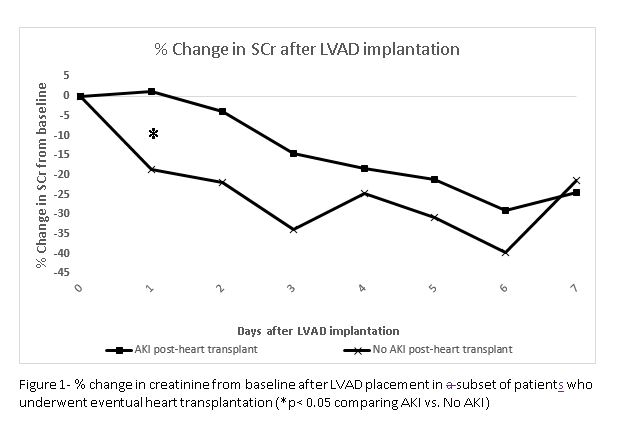Improved Creatinine Immediately Post-LVAD Predicts Lower AKI Risk After Heart Transplant.
1Nephrology, Cleveland Clinic, Cleveland, OH
2Heart and Vascular Institute,Thoracic and Cardiovascular Surgery, Cleveland Clinic, Cleveland, OH
3University of Rochester, Rochester, NY
Meeting: 2017 American Transplant Congress
Abstract number: C91
Keywords: Heart assist devices, Heart transplant patients, Renal failure
Session Information
Session Name: Poster Session C: Hearts and VADS: All Topics
Session Type: Poster Session
Date: Monday, May 1, 2017
Session Time: 6:00pm-7:00pm
 Presentation Time: 6:00pm-7:00pm
Presentation Time: 6:00pm-7:00pm
Location: Hall D1
Background-Left ventricular assist device(LVAD) placement often improves renal function in patients with advanced heart failure. In those bridged to transplant with LVAD support it is unknown if post-LVAD renal function improvement predicts post-transplant acute kidney injury(AKI) risk.
Methods-We analyzed 212 patients with an LVAD implanted between February 2008 and May 2013. Of these 64 underwent heart transplantation at a median(10th, 90th) interval of 8.9(4.5, 22.9) months post-LVAD. Repeated measures models were used to assess absolute and % change in serum creatinine(SCr) from baseline post-LVAD. AKI after transplant was defined as at least stage 1 AKI per Kidney Disease Improving Global Outcomes definition. Multivariate logistic regression model was created to assess an independent association between %Scr change from baseline on post-LVAD day 1 and AKI post-transplant.
Results- At time of LVAD mean age was 54 years, 81%(n=172) were male, 21%(n=44) were African American. Post-LVAD patients had maximum improvement in absolute and % change from baseline Scr of –0.2mg/dl and -28% by 7 and 6 days, respectively(p<0.01 for trend). Of 64 patients receiving a heart allograft 70%(n=45) experienced AKI post-transplant. Figure 1 shows a faster and more substantial decline in absolute and % change from baseline SCr on day 1 post-LVAD in those without AKI after eventual heart transplant compared to those with AKI post-transplant(-0.1 mg/dl and -19% vs 0.1 mg/dl and 1%, respectively; p=0.01).  Controlling for age, gender, race, time from LVAD, pre-LVAD and pre-transplant SCr, % change in SCr on the post-LVAD day 1 remained independently associated with AKI after eventual heart transplant(HR 0.21 for every 50% reduction in Scr from baseline on post-LVAD day 1, p=0.02).
Controlling for age, gender, race, time from LVAD, pre-LVAD and pre-transplant SCr, % change in SCr on the post-LVAD day 1 remained independently associated with AKI after eventual heart transplant(HR 0.21 for every 50% reduction in Scr from baseline on post-LVAD day 1, p=0.02).
Conclusion- There is significant improvement in renal function post-LVAD. In those bridged to transplant there is a lower risk of post-transplant AKI in those demonstrating more substantial immediate improvement in renal function post-LVAD.
CITATION INFORMATION: Nanavati A, He Y, Moazami N, Demirjian S, Stephany B. Improved Creatinine Immediately Post-LVAD Predicts Lower AKI Risk After Heart Transplant. Am J Transplant. 2017;17 (suppl 3).
To cite this abstract in AMA style:
Nanavati A, He Y, Moazami N, Demirjian S, Stephany B. Improved Creatinine Immediately Post-LVAD Predicts Lower AKI Risk After Heart Transplant. [abstract]. Am J Transplant. 2017; 17 (suppl 3). https://atcmeetingabstracts.com/abstract/improved-creatinine-immediately-post-lvad-predicts-lower-aki-risk-after-heart-transplant/. Accessed December 16, 2025.« Back to 2017 American Transplant Congress
